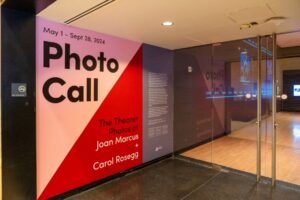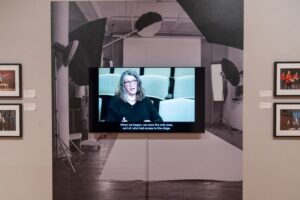“Photo Call: The Theater Photos of Joan Marcus and Carol Rosegg” at the Billy Rose Theatre Division, the New York Public Library for the Performing Arts. (Installation photo by Jonathan Blanc/NYPL)
In today’s image-saturated culture, the picture-weary among us may wonder, what’s the purpose of theatre photography? And, I would ask, how is it most fruitfully viewed?
According to wall text introducing the robust exhibit “Photo Call: The Theater Photos of Joan Marcus and Carol Rosegg” (on view at New York Public Library for the Performing Arts through Sept. 28), theatre photography sits somewhere between art photography, designed to showcase a photographer’s artistic vision, and photojournalism, unmodified documentation of a subject. Okay, so what does that mean for the viewer?

Art professor Monica Bravo (writing in this summer’s issue of Princeton University Art Museum Magazine) suggests that viewing photography requires looking both at and through—looking not only at what its surface image presents, but also through a photograph to glimpse conditions behind the scenes of its production. Particularly useful in appreciating the hybrid nature of theatre photography, those two ways of looking are beautifully prompted by the rewarding images of “Photo Call,” along with the library’s clever companion exhibit, “Reanimating Theater: The Photography of Friedman-Abeles” (on view through Sept. 25).
Curated by Doug Reside, “Photo Call” shows the astounding breadth of live theatre documentation achieved by photographers Joan Marcus and Carol Rosegg. It draws from the photographers’ vast archives, housed since 2018 in the library’s Billy Rose Theatre Division.
Though the two women shared a studio in Manhattan for more than two decades, they carved independent careers. A Pittsburgh native, Marcus photographed shows at the Kennedy Center and other Washington, D.C., theatres for 15 years, before moving to New York in 1992. She went on to shoot more than 1,000 productions, including numerous Broadway hits, and received a special 2014 Tony Honor for Excellence in the Theatre. Rosegg hails from Prairie Village, Kans., and started her career in New York in 1978, assisting prominent theatre photographer Martha Swope. In addition to Broadway, Rosegg photographed Off-Broadway, regional, and touring productions, and was the New York City Opera photographer for 30 years.
“Photo Call” opens with a captivating video timeline comprising enormous projections of multitudinous photos of New York stage productions taken by Marcus and Rosegg from 2003 to 2018. Organized chronologically, its images travel leisurely across the wall of a long narrow gallery, while a well-positioned bench invites one to sit for the more-than-four-hours it takes to view it all.
In accompanying wall text, Marcus explains that some of these photos are not strict documentation of what happened onstage, but rather “set-ups.” They present “images the audience will never see,” as they’re shot from the wings, from extreme angles, in altered lighting, or with re-positioned actors, scenery, or props. Her dramatic bird’s-eye-view photo of Twelve Angry Men allows us to see all twelve jurors at the same time, which one couldn’t see from the audience. To make her invigorating shot of The Who’s Tommy, the cast all gathered around a pinball machine, and the theatrical lighting and projections were re-balanced.

In a video-recorded interview with the photographers, continuously playing in the center of the gallery, we hear how their careers spanned the shift from film to digital photography. According to Marcus, in the pre-digital age, “there was a real technique to shooting theatre [that involved balancing light and color] which was why many people didn’t do it,” she said. “Now you can balance it all out in Photoshop.”
Rosegg recalls that when she started photographing theatre, “we were the only ones who had access.” Today, with the increasing demand for media content, actors are using their phones to produce all kinds of behind-the-scenes images. Yet as the exhibit demonstrates, theatre photography extends beyond documentation, and creating photos of enduring value requires more than access to an iPhone.
Much “insider” knowledge about the theatre industry is gleaned by looking through and considering what was happening in the making of Rosegg’s selected prints. From her complex 1979 shot of Romantic Comedy (reproduced in Playbill), we witness what went on back then at a show’s first rehearsal call, that initial meeting of cast, creatives, producers, and press agents. Aside from the Equity representative, the only “outsiders” allowed were photographers. While her colleagues jockeyed for space in front of stars Mia Farrow and Anthony Perkins, Rosegg stepped back and photographed the other photographers. Her action-filled image captures the entire event—creatives conversing at a table in the background, actors posing, and eager photographers squatting, reaching, and angling to get the best shot.
Support American Theatre: a just and thriving theatre ecology begins with information for all. Please join us in this mission by joining TCG, which entitles you to copies of our quarterly print magazine and helps support a long legacy of quality nonprofit arts journalism.

